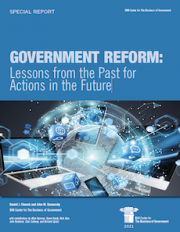
Reports
Tuesday, June 1, 2021
We surveyed 250 defense technology leaders from around the world to understand how defense organizations are using AI and how this technology will shape military operations going forward.
by Gwanhoo Lee
Wednesday, May 26, 2021
This report describes IoT as a network of physical “things” equipped with sensors and devices that enable data transmission and operational control with no or little human intervention.
Wednesday, May 5, 2021
Federal agencies are increasingly adopting cloud infrastructure, sharing their data across agencies and with the public, and relying on open source software (OSS) as they seek to enhance their capabilities, improve efficiency through IT modernization, and leverage their data for policymaking and administration.
Tuesday, April 20, 2021
The grants management landscape has changed over the past few decades, with new laws, administrative processes, technologies, and expectations for increasing the use of data and evidence to boost federal program the effectiveness.
Tuesday, March 23, 2021
This report provides an overview of the evolution of various federal government reform efforts over the past 30 years, with a focus on How government works to get things done for the American people, and the leaders in government who have and continue to implement important agency missions.
Wednesday, March 10, 2021
Environmental management and policy hold the potential to be an important data frontier.
Wednesday, February 24, 2021
Intelligent automation can be used for many tasks federal employees must spend hours to complete, particularly those involving paper forms and other written information.
Thursday, February 18, 2021
The Foundations for Evidence-Based Policymaking Act of 2018 includes a requirement that each agency develop an evidence-building plan to guide its research and evaluation efforts. This plan is often referred to as a “learning agenda.”
by Dr. Rodney Scott, Eleanor Merton, Gurdeep Gill, Laura Goddeeris, Maya McKenzie, Richard C. Feiock, Robert Handfield, Sherri Greenberg, Tad McGalliard, Zachary S. Huitink
Wednesday, February 10, 2021
In fall 2020, the IBM Center for The Business of Government initiated a Challenge Grant Competition soliciting essays from academics and practitioners describing how government can best transform the way it works, operates, and delivers services to the public in light of the impact of this pandemic.
by Jane Wiseman
Wednesday, December 16, 2020
The COVID-19 pandemic has clearly demonstrated the importance and value of being able to share data quickly between levels of government.













